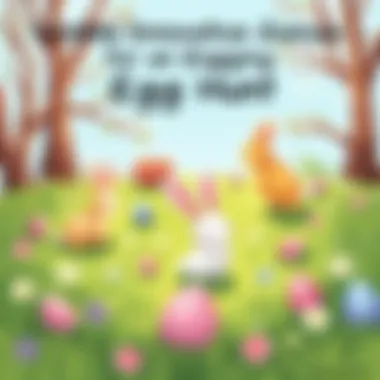Engaging Easter Egg Hunt Games for Kids


Intro
Easter is a time brimming with tradition, family gatherings, and the excitement of hidden treasures. While the classic Easter egg hunt undeniably holds a special place in many hearts, there's an opportunity to elevate this beloved custom into an engaging experience filled with learning and collaboration. By introducing games that cater to a variety of ages and skill levels, you can create a vibrant atmosphere that keeps both children and parents enthused.
In this article, we will explore a myriad of innovative games that not only offer the thrill of the hunt, but also incorporate educational and creative elements. From vibrant outdoor escapades that take advantage of springtime weather to snug indoor activities perfect for inclement days, the potential for a memorable Easter celebration is vast. We’ll provide insights tailored for parents and educators alike, ensuring that these activities remain fun while encouraging development and socialization among kids.
We’ll delve into several categories that span from fun activities and educational games to family bonding tips. Each section is designed to equip you with ideas that foster creativity and connection, turning a simple egg hunt into an enriching adventure. Let’s embark on this journey to reinvent Easter traditions and create lasting memories.
Prolusion to Easter Egg Hunt Games
Easter egg hunts have transcended mere holiday pastimes; they've evolved into cherished traditions that can significantly enrich children's lives. In our modern era, the excitement of the hunt extends beyond finding colorful eggs hidden in gardens and living rooms. This article sheds light on how innovative games integrated into Easter egg hunts can elevate the experience, fostering creativity and learning in an engaging manner.
Embracing the playful spirit of Easter, the incorporation of unique games not only enhances the traditional hunt but also allows for developmental benefits that are crucial in the early stages of a child's growth. Consider this: if kids are spending portions of their day actively searching and collaborating with peers, it's not just about the thrill of discovery but also about building vital social skills. Games can introduce elements of teamwork and communication, which are indispensable for young minds preparing for the complexities of life.
However, while planning these innovative games, it's essential to consider the setting and age group of participants. Factors such as the size of the venue, the number of participants, and varying skill levels can shape how these games are structured. For instance, younger kids might require simpler tasks, while older children can enjoy more complex challenges. Therefore, diversity in game design is key to ensuring every child feels included and engaged.
In this article, we'll explore various historical contexts of Easter egg hunts and underscore the significance of incorporating engaging games into this festive celebration. By providing a multifaceted approach to the traditional Easter egg hunt, we hope to equip parents, educators, and guardians with the tools necessary to foster a memorable and fulfilling experience for kids during this joyful occasion.
Outdoor Easter Egg Hunt Variations
The concept of an outdoor Easter egg hunt goes beyond merely hiding eggs for children to find; it serves as a delightful way to bring together families and communities while nurturing creativity and outdoor activity. Variations make this event even more engaging and help cater to different interests, age groups, and spaces. By incorporating various themes and formats, an outdoor Easter egg hunt can create lasting memories.
Scavenger Hunt Format
Transforming the traditional egg hunt into a scavenger hunt can increase both excitement and learning opportunities. In this format, children receive a list of items to find, which may include colored eggs, pebbles, or even natural treasures like leaves or flowers. This variation encourages exploration and curiosity, pushing kids to look beyond just the eggs.
For example, a scavenger list might look like this:
- 2 blue eggs
- 3 rocks that fit in your hand
- 1 flower
- 1 leaf
In this context, every found item becomes a small victory contributing to a larger adventure. It not only engages them physically but also mentally, as they must think critically and creatively to complete the task. The joy of finding something unexpected adds a layer of thrill. It’s like treasure hunting with a sweet twist!
Timed Challenges
Combining speed with excitement, timed challenges introduce a sense of urgency into the egg hunt. Parents can set a timer for 10 or 15 minutes, encouraging participants to gather as many eggs as possible before time runs out. This results in playful competition among peers, promoting camaraderie and challenging each child’s agility.
To add an educational layer, consider integrating a quiz element. For instance, after collecting eggs, kids may answer questions related to springtime or Easter themes to earn extra points for some of the eggs they found.
Timed challenges promote not only quick thinking but also enhance teamwork if conducted in group format.
Obstacle Course Integration
Imagine an egg hunt where kids must navigate an obstacle course! This variation truly takes outdoor fun to another level. By setting up hurdles, tunnels, and balance beams, children will not only search for hidden eggs but also develop motor skills and agility.
Here’s how to set it up:
- Designate a Start Point: Choose an area where all participants begin.
- Create Obstacles: Use items like cones, ropes, and garden ornaments to create hurdles.
- Egg Placement: Hide eggs both in plain sight and behind obstacles, requiring kids to climb, crawl or jump to retrieve them.


This format not only bumps up the excitement but also merges playtime with physical activity. The victory of completing the obstacle course combined with egg hunting elevates the experience, leaving lasting memories and a sense of accomplishment for every child.
Whether through scavenger hunts, timed races, or skill-based obstacle courses, the outdoor experience can turn a simple egg hunt into a memorable community event.
Indoor Easter Egg Hunt Ideas
Indoor Easter egg hunts provide a unique platform for creativity and fun, especially when the weather outside is less than favorable. These activities not only capitalize on the excitement of searching for hidden treasures but also foster imaginative thinking and problem-solving skills. By leveraging limited indoor spaces, an Easter egg hunt can transform into an engaging adventure where children explore, discover, and celebrate together.
Moreover, indoor hunts are conducive to family bonding and can be tailored to suit various age groups. From toddlers to pre-teens, there's always something for every child to enjoy, ensuring participants leave with smiles and cherished memories. Most importantly, these hunts can be organized with minimal resources, making them accessible and adaptable for anyone.
Clue-Based Hunts
A clue-based hunt takes the traditional egg hunt up a notch, incorporating riddles or hints that lead to the discovery of eggs. This format not only creates an exciting atmosphere but also encourages cognitive skills like critical thinking and teamwork. Parents can craft clues related to the children's interests, such as favorite cartoon characters or school subjects. An example might be, "Where do we keep the nighttime stories?" directed towards a bookshelf – a perfect nudge towards finding an egg hidden in a favorite book.
Utilizing this method, younger children may work in pairs with older siblings or adults assisting them, which builds camaraderie. On the other hand, older kids can enjoy the challenge by tackling more complex clues alone or in small groups. This variation not only promotes collaboration but also keeps all participants engaged, enhancing the overall experience.
Creative Egg Declarations
Decorating Eggs with Personal Touches
When it comes to creating memorable Easter eggs, personal touches reign supreme. Children can draw on their artistic skills, using paint, stickers, or even natural dyes derived from fruits and vegetables. This aspect of decorating isn’t just about aesthetics; it allows kids to express individuality.
The beauty of these custom creations is that every egg becomes a small masterpiece, perfect for showing off to family members. The activity stimulates fine motor skills and offers a great way for kids to bond with family or friends as they collaborate on their projects. Families can set aside a specific time for decoration, initiating a tradition that everyone looks forward to year after year.
One notable feature of this endeavor is that it can be adjusted for different skill levels. Young kids can stick to simple designs, while older kids might prefer intricate patterns. Not only does this foster budding artists, but it also enhances the festive spirit.
Using Different Materials for Easter Eggs
Exploring various materials for egg crafting opens a world of possibilities beyond the classic dyed eggs. Children can use paper mache, fabric, or even recycled materials to craft unique eggs. Using different materials allows for creativity to flourish. Kids can learn about sustainability by repurposing materials, which is an educational angle that adds depth to the fun.
For example, using fabric remnants can lead to soft eggs that can also serve as playful toys long after Easter. This process teaches children the value of resourcefulness. However, it requires adult supervision to ensure that tools and materials are safe and appropriate for each age group.
In terms of advantages, the learning aspect of this activity makes it an engaging choice. Still, one potential disadvantage is that the crafting process can be time-consuming, which might affect the overall schedule of an Easter feast or gathering.
Rainbow Egg Color Themes
Utilizing a rainbow theme can add vibrance to any Easter egg hunt. Kids can paint their eggs with bright colors that represent the colors of the spectrum, fostering discussions about colors and mixing techniques. This can lead to artistic experimentation with blending hues, sparking curiosity about color theory.
Setting up a rainbow egg hunt can involve placing each egg in specific areas based on color, guiding children through a colorful journey. For instance, reds might be hidden in the kitchen, while blues could be found in the living room. This not only makes hunting more strategic but also brings attention to visual organization.
Having a coherent theme encourages children to work together as they search for their eggs, creating an unforgettable Easter experience. Additionally, the colorful results can double as festive decorations around the house, prolonging the enjoyment of the holiday a bit longer.
Collaborative Group Games for Easter
Collaborative group games can elevate the traditional Easter egg hunt, adding layers of teamwork and creativity to the experience. These activities not only entertain but also foster bonds among participants. Children learn the value of cooperation and mutual support in these engaging environments. Parents and educators can take advantage of the inherent social dynamics in group games, promoting communication and problem-solving skills. Here, we explore some innovative collaborative game ideas that can make your Easter gatherings truly special.
Team-Based Egg Hunts


In a team-based egg hunt, children are divided into small groups, each tasked with finding eggs hidden on the hunt premises. Rather than competing against one another, team members collaborate to strategize their search, dividing responsibilities or assigning roles based on individual strengths. For instance, one child might scout ahead while another seeks hidden gems.
This variation adds a sense of excitement and urgency while nurturing essential skills like leadership and teamwork. To elevate the experience even further, consider introducing thematic clues or challenges that each team must solve before they can "unlock" certain eggs. For example, they might need to answer a riddle or complete a mini task related to Easter lore, which adds an educational twist to the excitement of egg finding.
Creative Egg Painting Contest
Another exhilarating group activity is a creative egg painting contest. Gather teams and provide each with a set of plain white eggs and art supplies like paint, markers, and glitter. You can set a theme for the eggs, such as “Springtime,” “Favorite Animal,” or “Superheroes.”
Each group has a fixed time to express their creativity while collaborating on their designs. This activity allows children to showcase their skills while gaining inspiration from their peers' choices and techniques. At the end of the contest, display the finished creations, and perhaps even hold a vote for the most imaginative design. Remember, it’s essential to ensure safety by providing non-toxic materials, in particular if younger kids are participating.
Trivia Challenges During the Hunt
A trivia challenge can be an engaging aspect of the egg hunt itself. While searching for eggs, children can encounter trivia questions related to Easter or springtime themes. This adds an educational element and keeps the participants mentally stimulated.
For example, you can hide special eggs that contain trivia questions and provide points for each correct answer. Depending on the age of the participants, these questions can range from simple facts about Easter traditions to more intricate questions regarding the season's significance in various cultures around the world.
This challenge not only tests their knowledge but also encourages learning and teamwork, as participants must collaborate to answer correctly and quickly. An effective game might involve setting a timer, requiring teams to answer as many questions as they can before the clock runs out.
These collaborative endeavors not only enhance the fun but also promote social skills development among children, creating memorable experiences that go beyond mere egg hunting.
Concluding Thoughts
Incorporating collaborative group games into your Easter egg hunt can transform an ordinary event into a rich and engaging experience. Whether through teamwork in egg hunts, artistic expression in painting contests, or educational trivia, these activities encourage children to bond, learn, and celebrate together. By focusing on collaboration, you create a memorable and fulfilling experience that will resonate with children long after the holiday is over.
For more ideas and resources on Easter games, check out Wikipedia or Britannica.
Educational Elements in Easter Games
Integrating educational elements into Easter games serves a dual purpose: fostering a fun-filled holiday while also promoting learning. These games create an atmosphere where children are not only entertained but also see the value in the skills they are developing. Introducing activities that intertwine lessons in math, language, and science enhances the traditional egg hunt, elevating it from mere amusement to a rich educational experience.
When parents and educators design these activities, they can capture a child’s natural curiosity and eagerness to learn. For instance, coupling the excitement of searching for eggs with challenges that require critical thinking lets children understand that learning can indeed be delightful.
"Learning through play is crucial, as it shapes not just knowledge, but essential skills like teamwork and problem-solving."
The beauty lies in the variety of opportunities for enrichment. Preparing for an egg hunt can also become a pathway to discussions about numbers, words, and the natural world. Through these games, children develop foundational skills—turning an occasion typically associated with sweets and frivolity into one rife with educational value.
Incorporating Math Challenges
Math can often feel dry, especially to younger children. However, by embedding math challenges into an Easter egg hunt, children can engage in number activities without it feeling forced. Consider creating a scavenger hunt that uses eggs with different numeric values written on them. Children could earn points based on the numbers they find, fostering a competitive yet educational spirit.
Possible activities include:
- Counting Eggs: Have a set total number of eggs hidden. After the hunt, children can share their findings, allowing for discussions about adding and comparing totals.
- Math Problem Eggs: Write simple math problems on some eggs. Once the eggs are found, children must solve them to earn rewards like extra treats or small gifts. This can facilitate a fun yet educational atmosphere.
- Geometry in Nature: Encourage students to find eggs in different shapes and sizes. This not only integrates shapes but also allows them to express their understanding in a playful manner.
Language and Vocabulary Games
Language development can seamlessly tie into Easter festivities by integrating fun vocabulary games into the hunt. Reading clues can turn the egg hunt into an educational extravaganza, pushing kids to understand and employ new words.


Consider these ideas:
- Riddle Clues: Instead of simply hiding eggs, write riddles or descriptive clues about where to find them. This approach offers children a chance to decode language and strengthens reading comprehension. An example clue might read, "Near the place where plants grow tall, a hidden egg lies where shadows fall."
- Word Scramble Challenge: Before or after the egg hunt, children can unscramble words associated with Easter or spring. This activity can pique interest in vocabulary while capturing the essence of the season.
- Story Creation: After the hunt, gather the children and ask them to create short stories based on their experience. This encourages creativity while improving their narrative skills and fosters camaraderie among the participants.
Science-themed Exploration
Integrating science into Easter games can usher in a sense of wonder and exploration. Children naturally ask questions about the world around them, and what better opportunity than during an egg hunt?
You can develop activities such as:
- Nature Scavenger Hunt: Alongside egg-hunting, introduce real-life objects to find, like different types of leaves, flowers, or insects. This nurtures observation skills and helps the children understand ecosystems.
- Egg Experiments: After the egg hunt, children can learn about eggs and their properties. A simple activity involves dropping uncooked eggs into various solutions to see what happens when they react with different ingredients.
- Lifecycle Learning: Incorporate mini-lessons on the lifecycle of rabbits or chickens, aligning the educational themes with the holiday's symbols. Through storytelling or discussions, participants can grasp biological concepts while engaged in thematic explorations.
In summary, incorporating educational elements into Easter games not only enhances the overall experience but also ensures that the lessons learned resonate long after the celebrations have concluded. By interweaving fun with foundational skills, parents and educators can craft memorable moments that genuinely contribute to a child’s growth.
Safety Considerations for Easter Activities
When planning an Easter egg hunt or other related games, ensuring safety should always be at the forefront of everyone’s mind. Especially when children are involved, the small details can make a big difference. Proper safety considerations can help prevent accidents, allowing the participants to focus on fun rather than worry. Here are several key areas to look into when organizing these activities.
Assessing Outdoor Environments
Conducting an Easter egg hunt in an outdoor setting brings joy, but it also requires diligent assessment of the environment. Before the day of the event, take time to evaluate the hunting location.
- Terrain Evaluation: Look for uneven ground or pathways that could cause trips and falls. Ensure that the grass is trimmed and remove any debris that could obstruct the children’s steps.
- Weather Readiness: Check the weather forecast. If rain is in the cards, prepare accordingly. Wet surfaces can lead to slips, so consider altering the plan if conditions do not look favorable.
- Traffic Awareness: If the hunt is near roads or driveways, set clear boundaries and briefly explain to the kids about staying in designated areas. Adults should maintain a watchful eye during the hunt.
- Animal Considerations: Minding the local wildlife is crucial. Pets or wild animals could pose a threat or distract children. Make sure any domestic animals are secured or kept away from the hunt site.
Taking the time to ensure all these factors are covered paves a smooth path for fun and discovery.
Managing Indoor Spaces
Indoor Easter egg hunts can be full of creativity and excitement, but they come with their unique set of challenges regarding safety. Since spaces can often be constrained, organization plays a pivotal role in ensuring that everyone has a great time without mishaps.
- Clear Clutter: Before the event, tidy up. Remove any obstacles or fragile items that could lead to accidents. Encouraging a safe path for children means keeping the floor free of toys and furniture.
- Safety Equipment: If you are using decorations or props, ensure they are child-friendly. Avoid sharp edges and small objects that may pose choking hazards.
- Exit Points: Ensure that all participants are aware of emergency exits in case of unforeseen events. Have a clear plan in place should an evacuation be necessary.
- Air Quality: Proper ventilation matters. Especially with indoor spaces filled with excitement, ensuring good air circulation keeps the environment healthy and prevents any stuffiness.
Proper planning and management of indoor spaces can significantly enhance the overall experience of Easter festivities, keeping everyone safe and sound.
In all, prioritizing safety in Easter activities allows everyone—children and parents alike—to enjoy the day worry-free. The little things add up to create a secure environment, setting the stage for a remarkable day filled with laughter, color, and joy.
Concluding Thoughts on Easter Egg Hunt Games
Easter egg hunts bring a delightful mix of excitement and learning to children during the special holiday. As we've explored throughout this article, innovative games elevate the traditional hunt, transforming it from a simple search for candy-filled eggs into a multifaceted experience that fosters creativity, teamwork, and educational growth. When it comes to engaging children, these activities not only entertain but also encourage critical thinking and social interaction among peers.
Review of Key Points
In summarizing our discussion, here are the pivotal elements that we covered:
- Historical Context of Easter Egg Hunts: Understanding the roots of this beloved tradition helps instill a sense of meaning in the activities.
- Outdoor and Indoor Variations: Whether outside in the sun or indoors on a rainy day, there are effective adaptations to ensure every child can participate in the fun.
- Collaborative Group Games: Encouraging teamwork enhances social skills and builds camaraderie among participants.
- Educational Elements: Integrating subjects like math, language, and science into games enables learning to continue even during play.
- Safety Considerations: Ensuring a safe environment is crucial, whether in a backyard or a gymnasium, to allow everyone to enjoy the festivities fully.
These key points lay the foundation for a well-rounded approach to planning engaging activities during the Easter celebration. It’s essential for parents and educators to embrace these elements to create an inviting atmosphere for children.
Encouragement for Creative Exploration
As we wrap up, I urge everyone involved in organizing Easter egg hunts – be it parents, teachers, or guardians – to think outside the box. A little creativity can go a long way in transforming a basic egg hunt into an unforgettable adventure. Why not blend scavenger hunts or team-based challenges into the traditional format? Explore various themes to keep things fresh.
- Personalize the experience by having kids create their own decoration style that reflects their unique tastes.
- Vary the contents of the eggs based on age group, ensuring older kids have a more challenging experience while keeping it light for younger ones.
- Experiment with themed hunts that encourage children to dress up or partake in interactive storytelling.
Innovation not only adds flair to Easter celebrations, it also provides children with memories to cherish for years to come. By respecting the spirit of the holiday while introducing novel ideas, we can enhance the experience and maintain its relevance for future generations. Let the creativity flow and make this Easter one to remember for every child involved.



